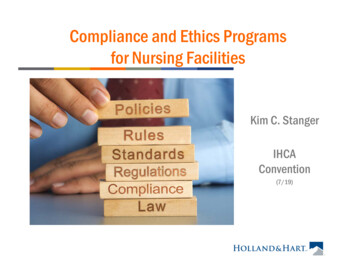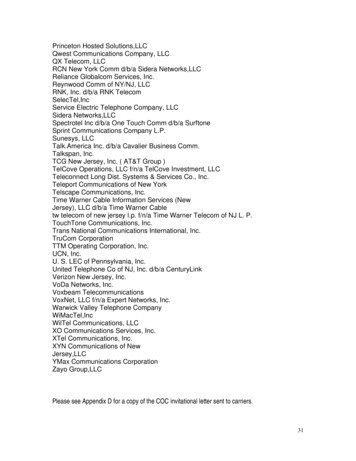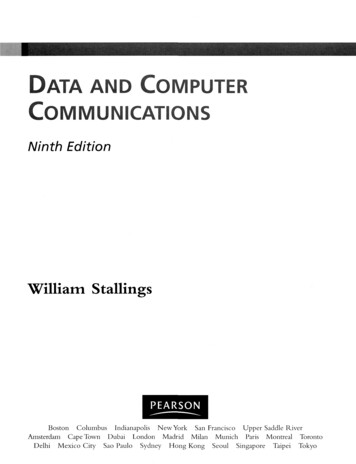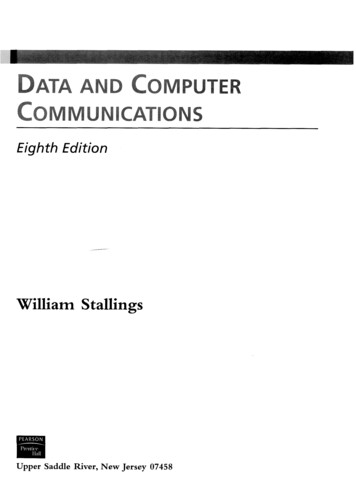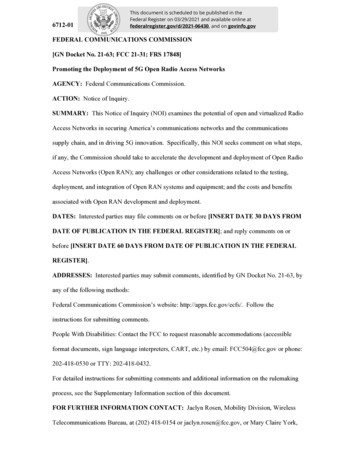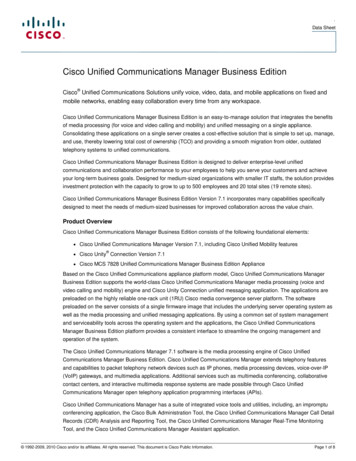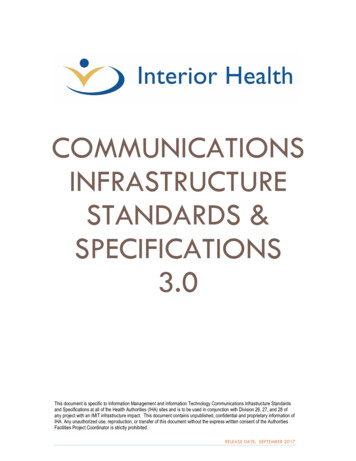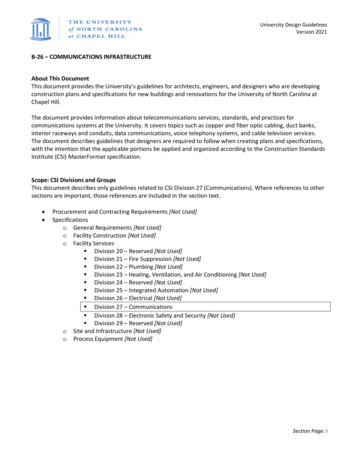
Transcription
University Design GuidelinesVersion 2021B-26 – COMMUNICATIONS INFRASTRUCTUREAbout This DocumentThis document provides the University’s guidelines for architects, engineers, and designers who are developingconstruction plans and specifications for new buildings and renovations for the University of North Carolina atChapel Hill.The document provides information about telecommunications services, standards, and practices forcommunications systems at the University. It covers topics such as copper and fiber optic cabling, duct banks,interior raceways and conduits, data communications, voice telephony systems, and cable television services.The document describes guidelines that designers are required to follow when creating plans and specifications,with the intention that the applicable portions be applied and organized according to the Construction StandardsInstitute (CSI) MasterFormat specification.Scope: CSI Divisions and GroupsThis document describes only guidelines related to CSI Division 27 (Communications). Where references to othersections are important, those references are included in the section text. Procurement and Contracting Requirements [Not Used]Specificationso General Requirements [Not Used]o Facility Construction [Not Used]o Facility Services Division 20 – Reserved [Not Used] Division 21 – Fire Suppression [Not Used] Division 22 – Plumbing [Not Used] Division 23 – Heating, Ventilation, and Air Conditioning [Not Used] Division 24 – Reserved [Not Used] Division 25 – Integrated Automation [Not Used] Division 26 – Electrical [Not Used] Division 27 – Communications Division 28 – Electronic Safety and Security [Not Used] Division 29 – Reserved [Not Used]o Site and Infrastructure [Not Used]o Process Equipment [Not Used]Section Page: i
University Design GuidelinesVersion 2021Table of ContentsAbout This Document . iScope: CSI Divisions and Groups . iTable of Contents . iiReferences. 1CIG01 – Communications . 7CIG02 – Testing and Acceptance of Cabling Systems. 16CIG03 - Grounding and Bonding for Communications Systems . 18CIG04 - Pathways for Communications Systems . 21CIG05 - Hangers and Supports for Communications Systems . 23CIG06 - Conduits and Backboxes for Communications Systems. 24CIG07 - Cable Trays for Communications Systems . 26CIG08 - Power Poles, Floor Boxes, and Poke Throughs for Communications Systems . 28CIG09 - Surface Raceways for Communications Systems . 29CIG10 - Underground Ducts and Raceways for Communications Systems . 30CIG11 - Rooftop Access for Communication Systems. 33CIG12 – Utility Poles for Communications Systems . 34CIG13 - Identification for Communications Systems . 35CIG14 - Schedules for Communications . 41CIG15 - Communications Entrance Protection . 45CIG16 - Communications Cabinets, Racks, Frames, and Enclosures. 46CIG17 - Communications Termination Blocks and Patch Panels . 47CIG18 - Communications Cable Management and Ladder Rack . 49CIG19 - Communications Equipment Room Fittings . 51CIG20 - Communications Copper Backbone Cabling . 55CIG21 - Communications Copper Cable Splicing and Terminations . 56CIG22 - Communications Optical Fiber Backbone Cabling . 57CIG23 - Communications Optical Fiber Splicing and Terminations. 60CIG24 - Communications Coaxial Backbone Cabling . 61CIG25 - Communications Copper Horizontal Cabling . 62CIG26 - Communications Coaxial Horizontal Cabling . 64Section Page: ii
University Design GuidelinesVersion 2021CIG27 - Communications Faceplates and Connectors .65CIG28 - Communications Custom Cable Assemblies .66CIG29 - Communications Patch Cords, Station Cords, and Cross Connect Wire.67CIG30 – Data Communications .68CIG31 - Voice Communications .69CIG32 – Telephone Sets .70CIG33 – Elevator Telephones .71CIG34 – Ring-Down Emergency Telephones .72CIG35 - Master Antenna Television Systems .73CIG36 – RF Systems .74CIG37 - Wi-Fi .75CIG38 - Cable Color Codes .76CIG-39 – Auxiliary Networks & Devices .77CIG-39 – Demolition .81Appendix 1: Telecommunications Designer Scope of Services .82Appendix 2: Submittals & Detailed Drawings.95Appendix 3: Pre-Installation Meeting.105Section Page: iii
University Design GuidelinesVersion 2021References1. AbbreviationsADAAmericans with Disabilities ActAFFAbove Finished FloorANSIAmerican National Standards InstituteATSAutomatic Transfer SwitchAWGAmerican Wire GaugeBBCBackbone Bonding Conductor (ANSI/TIA-607-C, equivalent to GE)BCTBonding Conductor for Telecommunications (ANSI/TIA-607-B and prior,equivalent to TBC)BICSIBuilding Industry Consulting Services InternationalCAConstruction AdministrationCATVCable Access Television System (sometimes called Master AntennaTelevision System)CDConstruction DocumentsCIGCommunications Infrastructure GuidelinesCSIConstruction Specifications InstituteCommTech EngineeringThe Communication Technologies Engineering group in the InformationTechnology Services Department at the University of North Carolina atChapel HillDASDistributed Antenna SystemDDDesign DevelopmentEIDFExtended Intermediate Distribution FrameEFEntrance FacilityELFEXTEqual Level Far End CrosstalkSection Page: 1
University Design GuidelinesVersion 2021EMTElectrical Metallic TubingETLElectrical Testing Laboratories (Intertek)GEGrounding Equalizer (ANSI/TIA-607-B and prior, equivalent to BBC)IDFIntermediate Distribution Frame, floor/area distribution point,horizontal cross-connectITSThe Information Technology Services Department at the University ofNorth Carolina at Chapel HillMDFMain Distribution Frame, building distribution point, main crossconnectMMMultimode (fiber optic cable)NECNational Electrical CodeNEXTNear End Cross TalkNFPANational Fire Protection AssociationOCCOptical Cable CorporationOEMOriginal Equipment ManufacturerOSPOutside Plant cabling or support structureOTDROptical Time Domain ReflectometerPBBPrimary Bonding Busbar (ANSI/TIA-607-C, equivalent to TMGB)PDFPortable Document Format from Adobe CorporationPLARPrivate Line Automatic RingdownPSTNPublic Switched Telephone NetworkRCDDRegistered Communications Distribution Designer (via BICSI)RFRadio FrequencyRFIRequest for InformationRGRadio GuideSection Page: 2
University Design GuidelinesVersion 2021RGSRigid Galvanized SteelSBBSecondary Bonding Busbar (ANSI/TIA-607-C, equivalent to TGB)SDSchematic DesignSCOState Construction OfficeSEPService Entrance PassthroughSERService Entrance RoomSMSingle Mode (fiber optic cable)TBBTelecommunications Bonding Backbone (ANSI/TIA-607-C and prior)TBCTelecommunications Bonding Conductor (ANSI/TIA-607-C, equivalentto BCT)TDMMTelecommunications Distribution Methods ManualTGBTelecommunications Grounding Busbar (ANSI/TIA-607-B and prior,equivalent to SBB)TIATelecommunications Industry AssociationTMGBTelecommunications Main Grounding Busbar (ANSI/TIA-607-B andprior, equivalent to PBB)TRTelecommunications RoomULUnderwriter’s LaboratoriesUNC-CHUniversity of North Carolina at Chapel HillVoIPVoice over IP2. Definitions Bonding Conductor for Telecommunications (BCT): A conductor that interconnects thetelecommunications bonding system to the main electrical service (power) grounding system. Division 27: Three-part CSI-formatted section of project manual concerning communications Duct Bank: Underground conduit set serving building from outsideSection Page: 3
University Design GuidelinesVersion 2021 Entrance Facility: Location of emergence of outside plant cabling in building Extended Intermediate Distribution Frame (EIDF): A space in a building that houses a small setof telecommunications equipment intended for a limited and specific purpose. EIDFs oftenconsist of ceiling or wall-mounted enclosures. Faceplate: A communications outlet frame into which communication inserts, blanks, and jacksare secured in support of voice, data, and video services. Floor Box: Opening in floor intended to provide electrical and communications outlets for aconference table or workstation or other area, usually away from a wall. Grounding Equalizer (GE): A conductor that interconnects two of more TBBs within a multistorybuilding. Intermediate Distribution Frame (IDF): A room in a building that houses telecommunicationsequipment for distribution of signals on a specific floor. In industry, this may be referred to as asatellite distribution room (SDR) or a floor distributor (FD). Main Distribution Frame (MDF): The primary room in a building in which activetelecommunications equipment is located. Typically, this equipment provides service to IDFslocated on other floors. In industry, this may be referred to as a primary distribution room (PDR)or a building distributor (BD). Patch Panel: Passive communications hardware utilized to terminate voice, data, security andsignaling cable with the purpose of identification and patching. Most often used to patch passivecabling to active components, patch panels may be mounted in equipment racks or be wallmounted. Poke Through: Conduit sleeve through a floor to the ceiling space of the floor below, providing apathway for communications cabling, typically utilized to serve conference rooms or modularfurniture. Power Pole: Vertical metallic raceway with a separate dedicated channels for electrical serviceand communications cabling, typically utilized to extend electrical and communications servicefrom a ceiling to modular furniture situated in open floor areas not adjacent to a wall. Ring-Down Emergency Phone: A wall-mounted or free-standing tower analog emergency phonewith central office generator backed up dial tone installed in parking decks and on campusgrounds. These emergency devices are equipped with a push button activation hook-switch thatwhen activated automatically dials the UNC Department of Public Safety Emergency OperationsCenter. SER-MDF: A combined service entrance room (SER) and main distribution frame (MDF). i.e., aroom that houses both the outside cable termination and the primary electronic distributionequipment. Service Entrance Passthrough (SEP): A room in a building in which a telecommunications cabletransitions from outside to inside and thence passes to a separate service entrance room.Section Page: 4
University Design GuidelinesVersion 2021 Service Entrance Room (SER): The primary room in a building in which telecommunicationscables terminate from their outside origin. In industry, this may be referred to as an EntranceFacility (EF). Static Load: In cable tray systems, the weight of the empty installed cable tray system togetherwith the weight of the installed cables. For equipment racks, the weight of the empty installedrack together with the weight of the installed equipment. Telecommunications Bonding Backbone (TBB): A conductor that bonds a TGB (usually in an IDF)to the TMGB (usually in the MDF.) Telecommunications Grounding Busbar (TGB): The primary telecommunications groundingconnection point in an IDF. Telecommunications Main Grounding Busbar (TMGB): The primary telecommunicationsgrounding connection point in the MDF, connected to the main building service equipmentground and to each TGB. Telecommunications Room (TR): Any room whose primary function is to containtelecommunications equipment, e.g. an SER, MDF, or IDF (but not necessarily a SEP or EIDF). Termination Block: Passive communications hardware utilized to terminate voice, data, securityand signaling cables with the purpose of identification and cross-connection. Typically wallmounted and most often used to cross-connect voice circuits.3. Reference DocumentsDesigners shall utilize the following standards or the latest versions thereof when developingspecifications for communication systems at the University of North Carolina at Chapel Hill. BICSI, Telecommunications Distribution Methods Manual, 12th Edition National Fire Protection Association, NFPA-70 (2011), National Electrical Code Telecommunications Industry Association, TIA-568-C.0 (February 2012), GenericTelecommunications Cabling for Customer Premises Telecommunications Industry Association, TIA-568-C.1 (February 2009), Commercial BuildingTelecommunications Cabling Standard Telecommunications Industry Association, TIA-568-C.2 (August 2009), Balanced Twisted-PairTelecommunications Cabling and Components Standards Telecommunications Industry Association, TIA-568.3-D.3 (October 2016), Optical Fiber Cablingand Components Standard Telecommunications Industry Association, TIA-568-C.4 (July 2011), Broadband Coaxial Cablingand Components Standard Telecommunications Industry Association, TIA-598-C (January 2005), Optical Fiber Cable ColorCodingSection Page: 5
University Design GuidelinesVersion 2021 Telecommunications Industry Association, TIA-606-B (June 2012), Administration Standard forTelecommunications Infrastructure Telecommunications Industry Association, TIA-607-C (November 2015), GenericTelecommunications Bonding and Grounding (Earthing) for Customer Premises Telecommunications Industry Association, TSB-140 (February 2004), Additional Guidelines forField-Testing Length, Loss and Polarity of Optical Fiber Cabling SystemsSection Page: 6
University Design GuidelinesVersion 2021CIG01 – Communications1. IntroductionThe telecommunications infrastructure of the University of North Carolina at Chapel Hill is afoundational element of the institution’s academic, research, and service environments. The scale ofthis infrastructure is a reflection of the size of the campus, including over 720 acres and millions ofsquare feet of buildings. In many respects, the University’s telecommunications infrastructure iscomparable to that of a small city, with similar requirements and challenges. Its complexity is areflection of the long history and evolution of voice, data, and video technologies throughout thecampus.Communications infrastructure guidelines (including this document) are managed on behalf of theUniversity by the Communication Technologies Engineering Group (CommTech Engineering) in theInformation Technology Services (ITS) Division of the University. Of course, wiring standards arecomplex and evolve rapidly to keep pace with the technology requirements of the University. As aresult, designers and contractors must consult with CommTech Engineering for clarification aboutcurrent cable types and standards before completing telecom designs and specifications, purchasingmaterials, and commencing work.This Communications Infrastructure Guidelines document is of a general nature and is intended toinform the development of a project’s design documents and guide the construction process.Specifications may be modified by the University’s Communication Technologies Office as necessary toaccommodate design or functional requirements of specific projects.For all new and renovated buildings and facilities, the scope of this guideline includes but is not limitedto underground service entrance ducts and cables, telecommunications rooms, pathway and conduitriser systems, and building telecommunications wiring.2. The Campus Communications EnvironmentThe campus is provisioned with an extensive underground duct bank system and outside cable plant.The outside cable plant includes legacy copper trunk cables, legacy coaxial cables, and an extensivenetwork of fiber optic cables. Going forward the outside cable plant will consist primarily of fiber opticcables except in rare instances. In some cases, locations remote from the campus are served bybroadband RF microwave systems.Each building is typically provisioned internally with fiber, copper, and coaxial cables. Outside plantcables terminate in a service entrance room, providing connectivity to a main distribution frame.Intermediate distribution frames on each floor provide horizontal connectivity.Together, the outside and inside cable plants support multiple services including Ethernet for data andVoIP telephony, backhaul for mobile data services, security systems and cameras, CATV, energymanagement, and traditional POTS telephony.Section Page: 7
University Design GuidelinesVersion 20213. Designer of Record ResponsibilitiesEach University project shall include a full telecommunications wiring infrastructure design, includinghorizontal and vertical cabling, telecommunications room racks and treatment, and linkages to outsidecable plant as appropriate. Each design shall include reviewed and approved plans and specifications(construction documents) that are a part of each project’s overall set of construction contractdocuments. Each design shall comply with the requirements of this guideline.At the beginning of the design process, the Designer of Record shall review in detail the currentCommunications Infrastructure Guidelines, and contact CommTech Engineering to determine if thereare any unusual criteria that pertain to the project.The Designer of Record shall harmonize the Communications Infrastructure Guidelines with the overallproject contract requirements, along with national, state, and local codes and regulations.All exceptions to these guidelines must be reviewed and approved by CommTech Engineering prior toimplementation.The Designer of Record shall be required to attend at least one face-to-face meeting between theDesigner’s telecommunications experts and CommTech Engineering, prior to commencingtelecommunications infrastructure design activities on any project. This shall be coordinated throughthe UNC-CH Facilities Planning and Construction Management Office.The Designer of Record shall ensure that all telecommunications infrastructure plans and specificationsare provided to CommTech Engineering as required in the Submittals section of this documentThe Designer of Record is responsible for ensuring that telecommunications infrastructure plans andspecifications are appropriately communicated and enforced across relevant construction trades. Inparticular, electrical and telecommunications systems shall be closely coordinated, especially withregard to grounding and conduit systems.A detailed list of the responsibilities of the Designer of Record can be found in Appendix 1.The full body and content of the University Design Guidelines are hereby incorporated by nes/).4. Contractor of Record ResponsibilitiesFor the purposes of this guideline, the Contractor of Record (or “Contractor”) shall be collectivelydefined as the Prime or General Contractor (and/or Construction Manager at Risk) and anysubcontractor, sub-trade or installer thereunder.The Contractor of Record will be required to purchase, install, test, and document all communicationsinfrastructure systems and components as specified within the Designer of Record’stelecommunications infrastructure plans and specifications. The Contractor of Record may be requiredto provide communications manholes/duct bank within the scope of selected projects and associatedconstruction contract documents.The Contractor of Record shall be required to attend at least one face-to-face meeting between theContractor’s telecommunications experts and CommTech Engineering, prior to commencingSection Page: 8
University Design GuidelinesVersion 2021procurement or other telecommunications infrastructure work on any project. This meeting shall becoordinated through the UNC-CH Facilities Planning and Construction Management Office.The Contractor of Record shall submit all communications equipment and materials for review andapproval by both the Designer of Record and CommTech Engineering prior to any procurement asdescribed in the Submittals sections of this document. The Contractor of Record shall refer to theproject bid document and the construction contract documents for all details of scope andresponsibility.Along with equipment and materials submittals, the Contractor of Record shall include the names andcontact information for any telecommunications subcontractors or installers, which shall be subject toreview and approval by both the Designer of Record and CommTech Engineering. During the projectconstruction phase, the Contractor of Record shall not be permitted to change telecommunicationssubcontractors or installers without the express written permission of UNC-CH Facilities Planning andConstruction Management Office, and CommTech Engineering. The Contractor of Record is responsiblefor all testing. See “Execution Testing and Acceptance” of this section for full requirements.The Contractor of Record is responsible for ensuring proper coordination across subcontract trades. Inparticular, coordination between electrical subcontractors and telecommunications subcontractors iscritical. For example, in some cases bonding systems and conduit systems may be installed either by theelectrical or telecommunications contractor. Both must be kept abreast of the specifications andcontract requirements.5. Design Scope: Network Electronics vs InfrastructureWhile the Designer of Record is responsible for physical communications infrastructure (wiring,telecommunications rooms, pathway, ductbank, etc.) as detailed in this document, the Designer ofRecord is not responsible for network electronics, except for providing adequate rack space, power,cooling, etc. The University generally handles the selection and installation of network electronics(switches, routers, wireless access points, telephones, etc.) itself. As such, these devices are out ofscope and should not be included in the design.Include in Design Package: Ductbank and service entrance infrastructure (section CIG10) Telecom rooms including racks, patch panels, cable management, access control, andtreatments (sections CIG03, CIG16, CIG17, CIG18, CIG19) Horizontal and riser cabling systems for data, voice, and CATV (sections CIG20, CIG21, CIG22,CIG23, CIG24, CIG25, CIG26, CIG27) Wi-Fi cabling design (section CIG37) Conduit, raceway, and other pathway components (section CIG04, CIG05, CIG06, CIG07, CIG08,CIG09) Electrical service and grounding systems (sections CIG03, CIG19) Rooftop access (section CIG11)Section Page: 9
University Design GuidelinesVersion 2021 HVAC (section CIG19) Testing and documentation (section CIG02, CIG13, CIG14)Do Not Include: Switches, routers, wireless access points Telephones or VoIP instruments Patch cablesSection Page: 10
University Design GuidelinesVersion 2021Section Page: 11
University Design GuidelinesVersion 20216. Qualifications6.1.Designer of Record QualificationsThe Designer of Record must have at least five (5) years of experience in the successful developmentof specifications and designs for telecommunications infrastructure in projects of a similar scale andcomplexity as the proposed project.UNC-CH requires that the Designer of Record maintain a currently-certified RCDD on the projectteam that can be available for all project meetings and significant communications with CommTechEngineering.6.2.Telecommunications Contractor of Record QualificationsThe Telecommunications Contractor of Record shall be duly licensed in the State of North Carolina.The Telecommunications Contractor of Record shall have at least 5 years of verifiable installationexperience with projects utilizing unshielded twisted pair (UTP), Category 6, and Category 6A cablingin compliance with the latest edition of TIA-568 and related industry standards.The Telecommunications Contractor of Record shall have at least one duly licensed RCDD on staff.Also on staff shall be a Hubbell MCCI certified installer. Certificates verifying these credentials shallbe submitted with bid documents.The Telecommunications Contractor of Record’s lead telecommunications technician shall be BICSIcertified with such certification at least at the technician level. The same technician shall be the leadtechnician for the duration of the project or shall be replaced by a technician with the same orhigher credentials and qualifications. Proof of BICSI Technician qualification shall be submitted withbid documents.Grounding and bonding systems shall be installed by a contractor duly licensed in the State of NorthCarolina for the installation of electrical conductors.Where the installation of any rooftop access assembly requires the penetration or compromise of abuilding roof, the Contractor of Record shall be certified to perform such work specific to the exactexisting roofing system and type.6.3.Manufacturer QualificationsUnless otherwise approved by CommTech Engineering, all materials shall be provided bymanufacturers regularly engaged in the manufacture of unshielded twisted pair, coaxial cables, fiberoptics, connectors, hardware, and related systems.Manufacturers must have products in satisfactory use for a minimum of five years.Section Page: 12
University Design GuidelinesVersion 20217. Execution7.1.Telecommunications Designer Scope of ServicesThe designer shall provide a complete telecommunications design package. A full enumeration of allservices and their associated construction phases can be found in Appendix 1.7.2.Pre-installation MeetingThe Contractor shall attend a meeting with CommTech Engineering prior to commencing installationactivities. This meeting will be held at UNC-CH at a location determined by CommTech Engineeringand may include a site visit. The purpose of the meeting is to review project specifics andrequirements. See Appendix 3 for details.7.3.Installation Methods GovernanceInstallation of all systems and materials shall be accomplished in accordance with this do
Telecommunications Cabling and Components Standards Telecommunications Industry Association, TIA-568 .3-D.3 (October 2016), Optical Fiber Cabling and Components Standard Telecommunications Industry Association, TIA-568 -C.4 (July 2011), Broadband Coaxial Cabling and Components Standard

